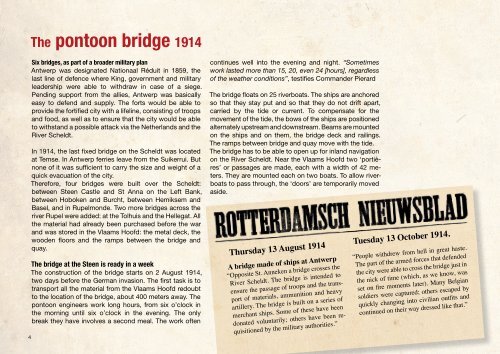Antwerpen14-18_Antwerp builds bridges ENG
Antwerpen14-18_Antwerp builds bridges ENG
Antwerpen14-18_Antwerp builds bridges ENG
You also want an ePaper? Increase the reach of your titles
YUMPU automatically turns print PDFs into web optimized ePapers that Google loves.
The pontoon bridge 1914<br />
4<br />
Six <strong>bridges</strong>, as part of a broader military plan<br />
<strong>Antwerp</strong> was designated Nationaal Réduit in <strong>18</strong>59, the<br />
last line of defence where King, government and military<br />
leadership were able to withdraw in case of a siege.<br />
Pending support from the allies, <strong>Antwerp</strong> was basically<br />
easy to defend and supply. The forts would be able to<br />
provide the fortified city with a lifeline, consisting of troops<br />
and food, as well as to ensure that the city would be able<br />
to withstand a possible attack via the Netherlands and the<br />
River Scheldt.<br />
In 1914, the last fixed bridge on the Scheldt was located<br />
at Temse. In <strong>Antwerp</strong> ferries leave from the Suikerrui. But<br />
none of it was sufficient to carry the size and weight of a<br />
quick evacuation of the city.<br />
Therefore, four <strong>bridges</strong> were built over the Scheldt:<br />
between Steen Castle and St Anna on the Left Bank,<br />
between Hoboken and Burcht, between Hemiksem and<br />
Basel, and in Rupelmonde. Two more <strong>bridges</strong> across the<br />
river Rupel were added: at the Tolhuis and the Hellegat. All<br />
the material had already been purchased before the war<br />
and was stored in the Vlaams Hoofd: the metal deck, the<br />
wooden floors and the ramps between the bridge and<br />
quay.<br />
The bridge at the Steen is ready in a week<br />
The construction of the bridge starts on 2 August 1914,<br />
two days before the German invasion. The first task is to<br />
transport all the material from the Vlaams Hoofd redoubt<br />
to the location of the bridge, about 400 meters away. The<br />
pontoon engineers work long hours, from six o’clock in<br />
the morning until six o’clock in the evening. The only<br />
break they have involves a second meal. The work often<br />
continues well into the evening and night. “Sometimes<br />
work lasted more than 15, 20, even 24 [hours], regardless<br />
of the weather conditions”, testifies Commander Pierard<br />
The bridge floats on 25 riverboats. The ships are anchored<br />
so that they stay put and so that they do not drift apart,<br />
carried by the tide or current. To compensate for the<br />
movement of the tide, the bows of the ships are positioned<br />
alternately upstream and downstream. Beams are mounted<br />
on the ships and on them, the bridge deck and railings.<br />
The ramps between bridge and quay move with the tide.<br />
The bridge has to be able to open up for inland navigation<br />
on the River Scheldt. Near the Vlaams Hoofd two ‘portières’<br />
or passages are made, each with a width of 42 meters.<br />
They are mounted each on two boats. To allow riverboats<br />
to pass through, the ‘doors’ are temporarily moved<br />
aside.<br />
Thursday 13 August 1914<br />
A bridge made of ships at <strong>Antwerp</strong><br />
“Opposite St. Anneken a bridge crosses the<br />
River Scheldt. The bridge is intended to<br />
ensure the passage of troops and the transport<br />
of materials, ammunition and heavy<br />
artillery. The bridge is built on a series of<br />
merchant ships. Some of these have been<br />
donated voluntarily; others have been requisitioned<br />
by the military authorities.”<br />
Tuesday 13 October 1914.<br />
“People withdrew from hell in great haste.<br />
The part of the armed forces that defended<br />
the city were able to cross the bridge just in<br />
the nick of time (which, as we know, was<br />
set on fire moments later). Many Belgian<br />
soldiers were captured; others escaped by<br />
quickly changing into civilian outfits and<br />
continued on their way dressed like that.”


